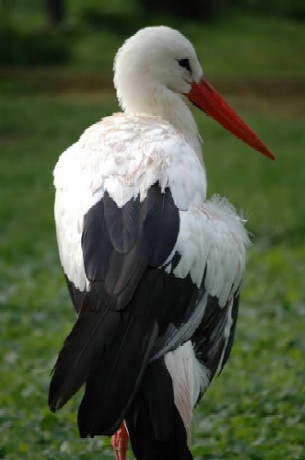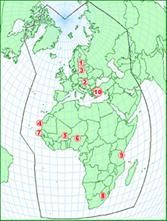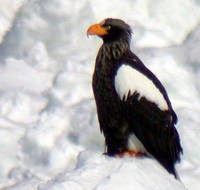Navigation
Wings over Wetlands: New Protection for Birds from Wetland and Waterbird Conservation Initiatives
The Wings Over Wetlands (WOW) Project launched on November 20, 2006, is the largest international wetland and waterbird conservation initiative ever to take place in the African-Eurasian region.
 |
White storks migrate annually between Africa and Eurasia. Photo: BirdLife and stock.xchng |
The Wings Over Wetlands (WOW) Project launched on November 20, 2006, is the largest international wetland and waterbird conservation initiative ever to take place in the African-Eurasian region. This 12 million US dollar project aims to conserve the critical areas needed by waterbirds migrating across these continents.
Key international organizations involved in the study and conservation of waterbirds are joining forces to improve understanding and flyway-scale protection of migratory waterbirds across Africa and Eurasia. Waterbirds migrate vast distances, and the project is designed accordingly, covering the entire African-Eurasian area, including Africa, Europe, the Middle East, Central Asia, Greenland and the Canadian Archipelago.
The German Federal Environment Minister Sigmar Gabriel congratulated with the words:
“Without the wintering areas for the white stork in Africa or the breeding areas in Siberia for the geese hibernating in the Wadden Sea, all protection efforts in Europe are useless. Acknowledging the need for wide ranging international flyway cooperation I welcome the international support of this project including an important German contribution of one million Euros”
The WOW Project is sponsored by the Global Environment Facility (GEF) through the UN Environment Programme (UNEP), the German Federal Ministry for Environment, Nature Conservation and Nuclear Safety, the Secretariat of the African-Eurasian Migratory Waterbird Agreement (UNEP/AEWA Secretariat), and several other donors.
 |
| Map of the African Eurasian Waterbird Agreement (AEWA) area. |
The project will help foster international collaboration along the entire flyways, build capacity for monitoring and conservation, and demonstrate best practice in the conservation and wise use of wetlands in 12 selected countries.
The WOW Project was designed and is now being implemented as a collaborative effort between Wetlands International and BirdLife International, with support from the United Nations Office for Project Services (UNOPS) and UNEP/GEF.
“Conservation of migratory waterbirds will depend on international cooperation between all countries on the migration routes as well as the engagement of local people in conserving the critical wetland sites. In developing countries, the livelihoods of local people as well as waterbirds depend on these wetlands and the water supplies that sustain them. The project will demonstrate how local and global action for wetlands conservation can benefit both people and nature”, says Ward Hagemeijer of Wetlands International, the global NGO leading the project.
“The WOW project is unique in combining a flyway-level perspective with an emphasis on practical conservation at the site and country level” says Leon Bennun, Director of Science, Policy and Information at BirdLife International. “Waterbird migrations are an extraordinary and very valuable natural phenomenon, which this project will help safeguard for the future.” Through its unique flyway-scale conservation approach, Wings Over Wetlands will enhance
international conservation efforts to improve the conditions and management of waterbirds and key wetland sites. The project will also pull together currently disparate data to create a flyway-level information portal that can assist conservation efforts and facilitate appropriate policy responses across the region. The central Web-based resource is being developed by the UNEP World Conservation Monitoring Centre and will enhance the ability to identify the networks of key sites throughout Africa and Eurasia migratory waterbirds use and depend on during their seasonal migrations.
 |
| Stellers Sea Eagle Photo by Pete Morris, Japan |
WOW operates in close coordination with the UNEP/AEWA Secretariat, the Ramsar Convention Secretariat and a wide range of local and international partners along the African-Eurasian flyways. “WOW is particularly significant as it will help countries to simultaneously deliver their commitments under a number of key Multilateral Environmental Agreements through one set of coordinated actions”, says Nick Davidson, Deputy Secretary General of the Ramsar Convention Secretariat.
"WOW supports the implementation of the AEWA Agreement in all 119 of its range states in Africa and Eurasia. We are working closely with the WOW team to maximize the involvement and collaboration with all our partners and countries across the AEWA region”, says Bert Lenten, Executive Secretary of AEWA, the international treaty dedicated to the conservation of waterbirds in Africa and Eurasia. Migratory waterbirds and the wetlands they use to complete their seasonal migrations are indispensable components of biodiversity and represent enormous recreational and economic benefits. Their ecology is still poorly understood and habitats and species are under increasing threat worldwide.
WOW will help identify sites that are critically important for waterbirds to complete their annual life cycle such as staging areas and wintering grounds that will be useful in assessing problems these species encounter on their annual journeys.
“Migrating birds see no borders. Conserving them and their critical habitats may only be achieved through improved collaboration between national governments, local and international conservation organizations and local communities. The WOW initiative will facilitate the exchange of expertise and synergies between a broad range of partners towards this common goal”, concludes Edoardo Zandri, Chief Technical Advisor of the WOW Project.
Note: Through its unique flyway-scale conservation approach, Wings Over Wetlands will not only enhance international conservation efforts to improve the conditions and management of waterbirds and key wetland sites in Africa and Eurasia, it will also create a new Web-based information portal that will be an improved source of reliable information on migratory flight paths across the continents.
Contact:
Florian Keil, Information Officer
UNEP/AEWA
Tel: +49 (0) 228 815 2451
Alex Kaat, Head of Communication at Wetlands International
Tel: +31 (0) 50601917
The African-Eurasian Flyways Project
Enhancing Conservation of the Critical Network of Sites required by Migratory Waterbirds
on the African-Eurasian Flyways
Adrian Long, Head of Communications at BirdLife International,
Tel: +44 (0)1223 279812
Nick Davidson, Deputy Secretary General at the Ramsar Convention
Tel: +41 22 999 01 71,
For more information please also consult the following sites:
Wetlands International WOW Project Page
UNEP/AEWA Website Announcement on WOW
http://www.wetlands.org/
http://www.birdlife.org/
http://www.unep-aewa.org/
http://www.ramsar.org/
http://www.unep-wcmc.org/
http://www.gefweb.org/
http://www.unep.org/
http://www.unops.org/unops/
UNEP Contact:
Jim Sniffen
Information Officer
UN Environment Programme
New York
tel: +1-212-963-8094/8210
UNEP is solely responsible for the contents of this press release.
Search
Latest articles
Agriculture
- World Water Week: Healthy ecosystems essential to human health: from coronavirus to malnutrition Online session Wednesday 24 August 17:00-18:20
- World Water Week: Healthy ecosystems essential to human health: from coronavirus to malnutrition Online session Wednesday 24 August 17:00-18:20
Air Pollution
- "Water and Sanitation-Related Diseases and the Changing Environment: Challenges, Interventions, and Preventive Measures" Volume 2 Is Now Available
- Global Innovation Exchange Co-Created by Horizon International, USAID, Bill and Melinda Gates Foundation and Others
Biodiversity
- It is time for international mobilization against climate change
- World Water Week: Healthy ecosystems essential to human health: from coronavirus to malnutrition Online session Wednesday 24 August 17:00-18:20
Desertification
- World Water Week: Healthy ecosystems essential to human health: from coronavirus to malnutrition Online session Wednesday 24 August 17:00-18:20
- UN Food Systems Summit Receives Over 1,200 Ideas to Help Meet Sustainable Development Goals
Endangered Species
- Mangrove Action Project Collaborates to Restore and Preserve Mangrove Ecosystems
- Coral Research in Palau offers a “Glimmer of Hope”
Energy
- Global Innovation Exchange Co-Created by Horizon International, USAID, Bill and Melinda Gates Foundation and Others
- Wildlife Preservation in Southeast Nova Scotia
Exhibits
- Global Innovation Exchange Co-Created by Horizon International, USAID, Bill and Melinda Gates Foundation and Others
- Coral Reefs
Forests
- NASA Satellites Reveal Major Shifts in Global Freshwater Updated June 2020
- Global Innovation Exchange Co-Created by Horizon International, USAID, Bill and Melinda Gates Foundation and Others
Global Climate Change
- It is time for international mobilization against climate change
- It is time for international mobilization against climate change
Global Health
- World Water Week: Healthy ecosystems essential to human health: from coronavirus to malnutrition Online session Wednesday 24 August 17:00-18:20
- More than 400 schoolgirls, family and teachers rescued from Afghanistan by small coalition
Industry
- "Water and Sanitation-Related Diseases and the Changing Environment: Challenges, Interventions, and Preventive Measures" Volume 2 Is Now Available
- Global Innovation Exchange Co-Created by Horizon International, USAID, Bill and Melinda Gates Foundation and Others
Natural Disaster Relief
- STOP ATTACKS ON HEALTH CARE IN UKRAINE
- Global Innovation Exchange Co-Created by Horizon International, USAID, Bill and Melinda Gates Foundation and Others
News and Special Reports
- World Water Week: Healthy ecosystems essential to human health: from coronavirus to malnutrition Online session Wednesday 24 August 17:00-18:20
- STOP ATTACKS ON HEALTH CARE IN UKRAINE
Oceans, Coral Reefs
- World Water Week: Healthy ecosystems essential to human health: from coronavirus to malnutrition Online session Wednesday 24 August 17:00-18:20
- Mangrove Action Project Collaborates to Restore and Preserve Mangrove Ecosystems
Pollution
- Zakaria Ouedraogo of Burkina Faso Produces Film “Nzoue Fiyen: Water Not Drinkable”
- "Water and Sanitation-Related Diseases and the Changing Environment: Challenges, Interventions, and Preventive Measures" Volume 2 Is Now Available
Population
- "Water and Sanitation-Related Diseases and the Changing Environment: Challenges, Interventions, and Preventive Measures" Volume 2 Is Now Available
- "Water and Sanitation-Related Diseases and the Changing Environment: Challenges, Interventions, and Preventive Measures" Volume 2 Is Now Available
Public Health
- Honouring the visionary behind India’s sanitation revolution
- Honouring the visionary behind India’s sanitation revolution
Rivers
- World Water Week: Healthy ecosystems essential to human health: from coronavirus to malnutrition Online session Wednesday 24 August 17:00-18:20
- Mangrove Action Project Collaborates to Restore and Preserve Mangrove Ecosystems
Sanitation
- Honouring the visionary behind India’s sanitation revolution
- Honouring the visionary behind India’s sanitation revolution
Toxic Chemicals
- "Water and Sanitation-Related Diseases and the Changing Environment: Challenges, Interventions, and Preventive Measures" Volume 2 Is Now Available
- Actions to Prevent Polluted Drinking Water in the United States
Transportation
- "Water and Sanitation-Related Diseases and the Changing Environment: Challenges, Interventions, and Preventive Measures" Volume 2 Is Now Available
- Urbanization Provides Opportunities for Transition to a Green Economy, Says New Report
Waste Management
- Honouring the visionary behind India’s sanitation revolution
- Honouring the visionary behind India’s sanitation revolution
Water
- Honouring the visionary behind India’s sanitation revolution
- Honouring the visionary behind India’s sanitation revolution
Water and Sanitation
- Honouring the visionary behind India’s sanitation revolution
- Honouring the visionary behind India’s sanitation revolution

